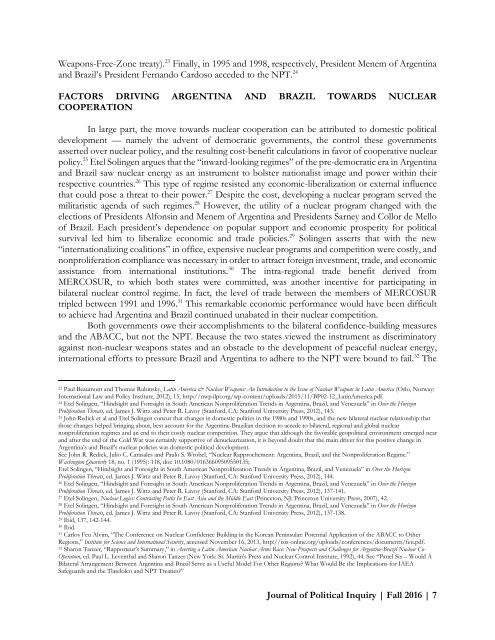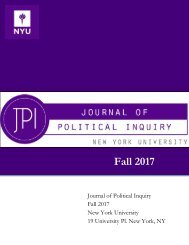Fall2016_Final
You also want an ePaper? Increase the reach of your titles
YUMPU automatically turns print PDFs into web optimized ePapers that Google loves.
Weapons-Free-Zone treaty). 23 <strong>Final</strong>ly, in 1995 and 1998, respectively, President Menem of Argentina<br />
and Brazil’s President Fernando Cardoso acceded to the NPT. 24<br />
FACTORS DRIVING ARGENTINA AND BRAZIL TOWARDS NUCLEAR<br />
COOPERATION<br />
In large part, the move towards nuclear cooperation can be attributed to domestic political<br />
development — namely the advent of democratic governments, the control these governments<br />
asserted over nuclear policy, and the resulting cost-benefit calculations in favor of cooperative nuclear<br />
policy. 25 Etel Solingen argues that the “inward-looking regimes” of the pre-democratic era in Argentina<br />
and Brazil saw nuclear energy as an instrument to bolster nationalist image and power within their<br />
respective countries. 26 This type of regime resisted any economic-liberalization or external influence<br />
that could pose a threat to their power. 27 Despite the cost, developing a nuclear program served the<br />
militaristic agenda of such regimes. 28 However, the utility of a nuclear program changed with the<br />
elections of Presidents Alfonsin and Menem of Argentina and Presidents Sarney and Collor de Mello<br />
of Brazil. Each president’s dependence on popular support and economic prosperity for political<br />
survival led him to liberalize economic and trade policies. 29 Solingen asserts that with the new<br />
“internationalizing coalitions” in office, expensive nuclear programs and competition were costly, and<br />
nonproliferation compliance was necessary in order to attract foreign investment, trade, and economic<br />
assistance from international institutions. 30 The intra-regional trade benefit derived from<br />
MERCOSUR, to which both states were committed, was another incentive for participating in<br />
bilateral nuclear control regime. In fact, the level of trade between the members of MERCOSUR<br />
tripled between 1991 and 1996. 31 This remarkable economic performance would have been difficult<br />
to achieve had Argentina and Brazil continued unabated in their nuclear competition.<br />
Both governments owe their accomplishments to the bilateral confidence-building measures<br />
and the ABACC, but not the NPT. Because the two states viewed the instrument as discriminatory<br />
against non-nuclear weapons states and an obstacle to the development of peaceful nuclear energy,<br />
international efforts to pressure Brazil and Argentina to adhere to the NPT were bound to fail. 32 The<br />
23<br />
Paul Beaumont and Thomas Rubinsky, Latin America & Nuclear Weapons: An Introduction to the Issue of Nuclear Weapons in Latin America (Oslo, Norway:<br />
International Law and Policy Institute, 2012), 15, http://nwp.ilpi.org/wp-content/uploads/2015/11/BP02-12_LatinAmerica.pdf.<br />
24<br />
Etel Solingen, “Hindsight and Foresight in South American Nonproliferation Trends in Argentina, Brazil, and Venezuela” in Over the Horizon<br />
Proliferation Threats, ed. James J. Wirtz and Peter R. Lavoy (Stanford, CA: Stanford University Press, 2012), 143.<br />
25<br />
John Redick et al and Etel Solingen concur that changes in domestic politics in the 1980s and 1990s, and the new bilateral nuclear relationship that<br />
those changes helped bringing about, best account for the Argentine-Brazilian decision to accede to bilateral, regional and global nuclear<br />
nonproliferation regimes and an end to their costly nuclear competition. They argue that although the favorable geopolitical environment emerged near<br />
and after the end of the Cold War was certainly supportive of denuclearization, it is beyond doubt that the main driver for this positive change in<br />
Argentina’s and Brazil’s nuclear policies was domestic political development.<br />
See John R. Redick, Julio C. Carasales and Paulo S. Wrobel, “Nuclear Rapprochement: Argentina, Brazil, and the Nonproliferation Regime.”<br />
Washington Quarterly 18, no. 1 (1995): 118, doi: 10.1080/01636609509550135;<br />
Etel Solingen, “Hindsight and Foresight in South American Nonproliferation Trends in Argentina, Brazil, and Venezuela” in Over the Horizon<br />
Proliferation Threats, ed. James J. Wirtz and Peter R. Lavoy (Stanford, CA: Stanford University Press, 2012), 144.<br />
26<br />
Etel Solingen, “Hindsight and Foresight in South American Nonproliferation Trends in Argentina, Brazil, and Venezuela” in Over the Horizon<br />
Proliferation Threats, ed. James J. Wirtz and Peter R. Lavoy (Stanford, CA: Stanford University Press, 2012), 137-141.<br />
27<br />
Etel Solingen, Nuclear Logics: Contrasting Paths In East Asia and the Middle East (Princeton, NJ: Princeton University Press, 2007), 42.<br />
28<br />
Etel Solingen, “Hindsight and Foresight in South American Nonproliferation Trends in Argentina, Brazil, and Venezuela” in Over the Horizon<br />
Proliferation Threats, ed. James J. Wirtz and Peter R. Lavoy (Stanford, CA: Stanford University Press, 2012), 137-138.<br />
29<br />
Ibid, 137, 142-144.<br />
30<br />
Ibid.<br />
31<br />
Carlos Feu Alvim, “The Conference on Nuclear Confidence Building in the Korean Peninsular: Potential Application of the ABACC to Other<br />
Regions,” Institute for Science and International Security, accessed November 16, 2013, http://isis-online.org/uploads/conferences/documents/feu.pdf.<br />
32<br />
Sharon Tanzer, “Rapporteur’s Summary,” in Averting a Latin American Nuclear Arms Race: New Prospects and Challenges for Argentine-Brazil Nuclear Co-<br />
Operation, ed. Paul L. Leventhal and Sharon Tanzer (New York: St. Martin's Press and Nuclear Control Institute, 1992), 44. See “Panel Six – Would A<br />
Bilateral Arrangement Between Argentina and Brazil Serve as a Useful Model For Other Regions? What Would Be the Implications for IAEA<br />
Safeguards and the Tlatelolco and NPT Treaties?”<br />
Journal of Political Inquiry | Fall 2016 | 7
















